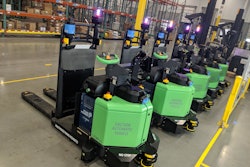
In the ever-evolving landscape of supply chain and logistics, the drive for efficiency and productivity never wanes. Palletizing automation has become an integral component in modern warehouses streamlining operations and enhancing effectiveness. Yet, as we automate more processes, we encounter new challenges, especially in adapting to unforeseen scenarios – an area in which human assistance remains indispensable to this day. It is here where wearable technology, such as in the form of exoskeletons, can emerge as a pivotal solution in heavy-lifting environments, bridging the gap in palletizing automation while harnessing the power of human ingenuity, adaptability and problem-solving capabilities, all while protecting the health and wellbeing of the workers.
Smart, Active Exoskeletons: Power, Versatility and Human Intelligence
Exoskeletons, and more specifically active – or powered – types, are already widely known for their role in enhancing workplace safety and protecting workers in all manner of industries wherever heavy lifting is involved. The most effective of these smart, wearable devices are fully connected and utilize artificial intelligence (AI) to offer not only significant benefits to businesses and users alike, but to also represent a pathway for the individualized support of workers and the integration of manual work into the digital age. Smart exoskeletons make it possible for the essential human dimension to be safely brought into palletizing automation and bridge the gap where human intelligence is irreplaceable, especially in scenarios involving the lifting of heavy items of varying forms, textures, and sizes – and for unexpected challenges. But what exactly are exoskeletons delivering to palletizing environments and how do they fit at all in terms of process automation?
A Bridge Between Human Ingenuity and Automation Efficiency
The integration of human intelligence into the automation process is a significant – and necessary – stride in modern supply chain management. While the level of automation continues to flourish in palletization operations, complete automation is still the exception rather than the norm in warehouses, especially in operations where items needing to be palletized are not in standard forms. The question of feasibility is also matched with the question of cost effectiveness of such solutions. In most cases, there is still a crucial need for the human touch to ensure palletization operations are conducted with high levels of efficiency and with complete reliability. It is here where exoskeletons can play a pivotal role in achieving this goal.
In an increasingly automated world, the role of human workers is not obsolete; it’s merely evolving. Humans possess a unique ability to adapt to unforeseen circumstances, troubleshoot problems, and make intuitive decisions that machines cannot replicate. This is where real synergies between palletization automation and human intelligence can be exploited.
Power Meets Versatility
Powered exoskeletons provide robust support for the lower back, significantly reducing the physical strain workers are subjected to during palletizing processes. By providing power-assist through their battery-driven robotic motors, the active exosuits enhance the capacity of workers to handle physically demanding tasks more safely, with greater ease and precision – which leads to reduced levels of fatigue and subsequently lower error rates. This power and versatility make them indispensable in warehouse settings, where the lifting of heavy objects of variable shapes and sizes is commonplace.The Magic Formula: AI + Connectivity
One size does not fit all when it comes to automation, workplace safety – or exoskeletons. A unique beauty of the cutting-edge connected exoskeletons lies in their ability to adapt to the specific needs of individual workers and situations. The connectivity and application of AI means that it can gather real-time data on a worker’s movements and posture. The information is then immediately analyzed and interpreted, which can subsequently make any necessary adjustments to provide optimal, fully personalized support.The smart power suits are also valuable for notifying users of instances of incorrect posture or lifting techniques – or when they should take a break in order to avoid fatigue. At the end of the day, an early warning system for ergonomics can lead to fewer incidents on the warehouse floor caused by excessive strain or accidents, which not only makes for safer and happier employees, but also for lower rates of illness and absenteeism while simultaneously resulting in higher levels of productivity.
Exoskeleton connectivity also encompasses the capability of integrating these devices into a company’s existing IT ecosystem. As such, they can contribute to seamless communication between workers, machines, and systems in real-time, thereby providing the potential to significantly optimize operations and transform manual work into an integral part of the digital workflow. This fusion of the human element with technology is a crucial step towards achieving a more efficient and responsive supply chain.
A Safer, More Efficient and Adaptive Future
The introduction of active exoskeletons not only enhances safety but also brings human intelligence and adaptability into the palletization equation. The coexistence of automation and human workers, supported by these wearable devices, provides a balanced approach to the challenges of palletizing, where unpredictability is the norm.
By embracing active exoskeletons, companies can significantly reduce workplace accidents and protect their workers from physical strain, especially in scenarios where items with diverse characteristics need to be palletized. But exoskeletons go a step further, enabling workers to step in when automated solutions face unexpected challenges. This fusion of automation, wearable technology and human ingenuity ensures a safer, more efficient and adaptive future for palletizing in the supply chain sphere.













![Pros To Know 2026 [color]](https://img.sdcexec.com/mindful/acbm/workspaces/default/uploads/2025/08/prostoknow-2026-color.mduFvhpgMk.png?ar=16%3A9&auto=format%2Ccompress&bg=fff&fill-color=fff&fit=fill&h=135&q=70&w=240)






